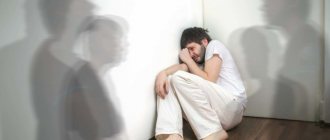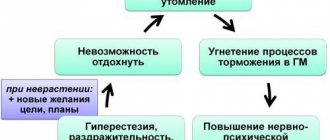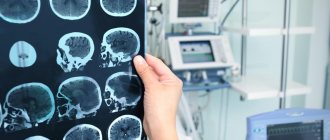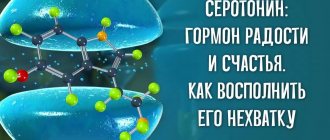History
| « | Having the misfortune of suffering from hallucinatory insanity for two years and retaining after recovery the ability to cause a certain kind of hallucination at will, I was naturally able to notice in myself some of the conditions for the origin of sensory delirium. | » |
| - psychiatrist Kandinsky. | ||
The syndrome is named after Viktor Kandinsky, the second cousin of the artist Wassily Kandinsky. In 1876-1877 Victor served in the navy as a ship’s doctor, participated in the Russian-Turkish War and suddenly felt that he had been “subjected” to the mental attack of the Tsarist secret police. But he seized control in time and went to psychiatry himself, where he was able to describe his experiences in the critical-clinical study “On Pseudohallucinations,” which was highly praised in his works by the luminary of psychiatry, Jaspers. In addition, he is considered the father of Russian forensic psychiatry.
To stop external “influence” on his brain, he committed suicide in the name of conspiracy at the peak of one of the attacks in 1889. through overload with substances.
There is not much interesting about the second half of the syndrome, about Clerambault: he was a similar schizophrenic psychiatrist-schizophrenic from France, “controlled” by Surte (this is a French FSO) and, independently of Kandinsky, described his symptoms of mental automatism.
He also came up with erotic delusions (Clerambault syndrome), the law of his name, and then fell into depression with delusions of guilt and shot himself.
Delusional – hallucinatory type of course
In this case, several options for the course of the disease are provided: delusional and hallucinatory:
- with the delusional variant of the course, a person develops various kinds of delusional ideas of persecution, influence, and pseudohallucinatory disorders, in turn, manifest themselves to a lesser extent or may be completely absent;
- whereas in the hallucinatory course , pseudohallucinations are observed, and there are practically no delusional disorders.
What is this
It consists of the three most important things that do not occur to the average person and are a set of productive symptoms:
- Pseudo-hallucinations are hallucinations within one’s subjective world, i.e. “music playing behind the wall” is a true hallucination, and “music playing in the head” or perceived by the “spiritual/internal” sense is a pseudo-hallucination. The voices in my head are here too.
- Ideas of influence (mental and physical) - a feeling of the influence of force from the outside: as if they are “putting” thoughts into your head, “speaking” with your mouth and “walking” with your feet. Someone's invisible influence and the action of the cosmos, extraneous forces, persecution are also here.
- The very phenomena of mental automatism: the feeling of one’s thoughts/movements/actions/feelings as if made, unnatural, alienated. This can also be called forced thinking, as if someone is forcing
you to think.
That is, the patient feels the influence of his sick consciousness and hears his thoughts, as if it were a separate part of him - this is not a split personality, this is precisely a “ split of the mind”
" - what is included in the very name of the disease
schizophrenia
.
Pathological automatisms are the most characteristic feature of those patients with schizophrenia who are under the influence of an otherworldly extraneous force, which is most clearly manifested by impulsive actions against the patient’s wishes. This behavior can be dangerous.
Mental automatisms
Continued - The feeling that someone else can control your thoughts.
The feeling that your thoughts, emotions, movements can be controlled or influenced in some way is a common symptom of disorders of the nervous system, one of the forms of manifestation of mental automatisms.
Such disorders can be either temporary and reversible, not requiring special medical care (benign), or they can also be manifestations of severe mental disorders and behavioral disorders that require urgent psychiatric care.
Options
All types have one thing in common: the connection of sensations with external influences. Often complemented by delusional symptoms, the result is delusional ideas of influence and persecution.
Ideatorial (associative)
Here, first of all, is the very investment of other people’s thoughts and the feeling of openness of one’s thoughts, which “may” be known to others. The sound of your thoughts appears (normally the act of thinking is inseparable
and
continuous
, it is impossible to look at it “from the outside”) and the alienation of one’s emotions: “they laugh at me,” “they sadden at me,” that is, as if this is not an independent, but a forced act, under
the influence
of something extraneous.
Senestopathic
This includes the entire “space” and devices with rays that cause pseudohallucinations, senestopathies and visceral hallucinations in the patient. That is, it not only seems to him that a surveillance device has somehow been “sewn under his skin” and he “feels” it, but this also happened thanks to unknown malicious rays from another galaxy/from neighbors/magical influences.
Motor (kinesthetic)
The patient considers all movements, including walking and turning his eyes, not his own, but under the influence of others. They “go” by controlling it. A special type of motor automatism is speech motor pseudohallucinations, as if all speech, pronunciation of words and movements of the tongue also occur from external influences, and not of one’s own free will.
Manifestation of mental automatisms
1. A person may experience feelings that someone else can control your thoughts, actions and sensations when poisoning with psychostimulants (amphetamines, methamphetamines, cocaine and others). In addition to thinking disorders, insomnia develops in such states, speech accelerates, impulsive actions and aggressive behavior appear. As a rule, after intoxication with psychostimulants ends, a sound and long sleep sets in, after which the feeling of openness of thoughts and the fact that they can be controlled disappears.
2. With severe alcoholism, passing from the second stage to the third, against the background of alcohol abstinence, after a period of insomnia, a special type of psychosis develops - delirium tremens (popularly known as “delirium tremens”). Such types of delirium have been described in which, with a relatively unclouded consciousness, the patient experiences influxes of sensations that someone else can control your thoughts.
4. The reason for the sensation of control over your other thoughts (in addition to poisoning by alcohol and its half-life products (acetaldehyde, ketone bodies, etc.) is a predisposition to endogenous diseases in the form of a special organization of higher mental functions. The outcome of such psychoses is different: from favorable with complete reverse development symptoms and restoration of thinking, to unfavorable with the development of a progressive endogenous disease with an increase in thinking disorders.
5. It should be noted that conditions in which there are feelings that someone else can control your thoughts can also be experienced by healthy people during periods of overwork or long-term stress.
In such cases, in addition to the sensations of thought control, sleep is disturbed (it becomes difficult to fall asleep, frequent and early awakenings appear).
In cases of overwork, the feeling that someone else can control your thoughts is most often not constant, not clearly expressed, and after resting with long and deep sleep, it stops completely.
It should be emphasized that the feeling that someone else can control your thoughts is a good reason to visit a psychiatrist or psychotherapist to make sure that there is no disease or if, nevertheless, signs of a disorder are identified, it will be possible to begin adequate treatment which requires urgent medical attention.
Back to first page - The feeling that someone else can control your thoughts.
More
- What's next
| [ + ] Kandinsky-Clerambault syndrome? Welcome. | |
| Diseases | Schizophrenia • Drug addiction (Alcoholism) • Depression • Anxiety • Panic disorder • Bipolar disorder |
| States | Deja vu • Kandinsky-Clerambault syndrome • Down syndrome • Magifrenia • Fanaticism • Suicide • Anosognosia • Hysterical coma • Dementia (Oligophrenia • Dementia • Idiot) • ADHD |
| Phobias | Dysmorphophobia • Trypophobia |
Hallucinatory-paranoid syndrome
The disease develops acutely or can become chronic:
- with the acute development of this disease, the symptoms are not systematized and are accompanied by fear, catatonicism and strongly expressed mental automatisms;
- if the course is chronic , then delusional ideas take on a systematized character, the effect of anxiety decreases, and there is no confusion.
Mental automatisms with this option appear gradually, first associative, then sensory and motor.
Note! In the acute stage, alienation phenomena may be observed.
Treatment and rehabilitation measures
Treatment of alienation syndrome and external influence includes an integrated approach: drug therapy, psychotherapeutic intervention and a rehabilitation period are necessary. The patient is hospitalized in an inpatient psychoneurological department, where a whole range of therapeutic measures is carried out with him.
Among the medications, those that contribute to the emotional stabilization of the patient are selected. Usually these are psychotropic substances, neuroleptics, antidepressants - medications that inhibit certain nervous processes (Haloperidol, Clozapine, Triftazine).
As soon as there is an improvement in the patient’s condition and he begins to realize what is happening, psychotherapeutic measures are carried out.
The rehabilitation period is a mandatory stage of the general treatment tactics, and it turns out to be the longest. At this time, the patient is recommended to:
- attending both individual and group psychotherapy sessions;
- following a special diet that does not contain food containing copper;
- physical activity, physical therapy classes.
If the external influence syndrome is complicated by various psychoses, long-term adaptation of the patient is required under constant medical supervision.
Traditional medicine is unable to cope with the disease on its own. They are effective only when used in combination as maintenance therapy.
An individual approach is required in treating the disease and preventing relapses. The course is selected by the doctor after making an accurate diagnosis and examining the patient.
Features of the course of the disease
Kandinsky Clerambault's mental automatism syndrome, like other mental illnesses, develops in several stages, which are characterized by certain symptoms and severity.
During the syndrome, there are two forms: acute and chronic:
- In the acute course of the disease, all the patient’s symptoms manifest clearly. In this case, the patient is quite active, talkative, but at the same time easily irritable and aggressive. Some patients experience a very strong feeling of fear. This form lasts up to three months, and is accompanied by pseudohallucinations with attacks of delusional ideas. Such ideas completely embrace the patient, which completely takes the person out of normal life. In such patients, symptoms often change, obsessive states or pain changes its location.
- The development of the chronic form occurs over several years. Clinical manifestations begin to gradually increase: signs of ideational automatism appear first, followed by phenomena of motor or sensory automatism. The manifestations of this form of the disease are so vague that it is difficult to diagnose.
Note. Often, delusional states occur in a mild degree of severity, which is difficult to determine when examining such a patient.
Etiology and pathogenesis
Since Kandinsky-Clerambault syndrome is detected primarily in schizophrenia, much less often in exogenous-organic psychoses, and even less often in epilepsy, the cause of its occurrence is associated with the etiology of these diseases. Psychogenetic point of view on K.—K. pp., shared by certain French. and domestic psychiatrists, was refuted by V. X. Kandinsky and M. Clerambault and continues to remain a subject of debate.
The modern explanation of the mechanism of mental automatisms is based on the teachings of I. P. Pavlov about pathodynamic changes in. n. d. According to him, the entire hallucinatory-paranoid picture with the phenomena of alienation, violence, phenomena of influence and mastery is regarded as a reflection of a pathologically inert irritable process in c. n. p., which either, according to the law of generalization, concentrates everything abnormal around itself, then, according to the law of induction, repels everything that is normal physiological and psychological. From this follows the hypothesis of A. A. Mehrabyan (1972) about the violation of Gnostic feelings in the general structure of thinking, speech, activity and self-awareness, leading to the functional disintegration of the psyche - through deautomatization to depersonalization.
Treatment and psychotherapeutic correction
Therapeutic measures for mental automatism are complex. In addition to drug treatment based on the use of antidepressants and drugs from the antipsychotic group, various psychotherapeutic practices are used
It is important to note that after treatment, the patient will face long-term rehabilitation
It is worth noting that the duration of rehabilitation may vary. The basis of the rehabilitation period is psychotherapeutic correction, physical therapy sessions and adherence to the correct diet. The patient must follow a strict diet throughout the entire recovery period, excluding from the daily diet all products that contain copper.
To reduce the likelihood of relapse, the patient should pay great attention to his physical activity. Moderate exercise, walks in the fresh air and visiting the pool can improve your well-being
Relatives of a person with a mental disorder should be aware of the importance of understanding and support during this difficult period. Caring for a loved one can not only have a beneficial effect on their emotional state, but also reduce the time required for recovery







